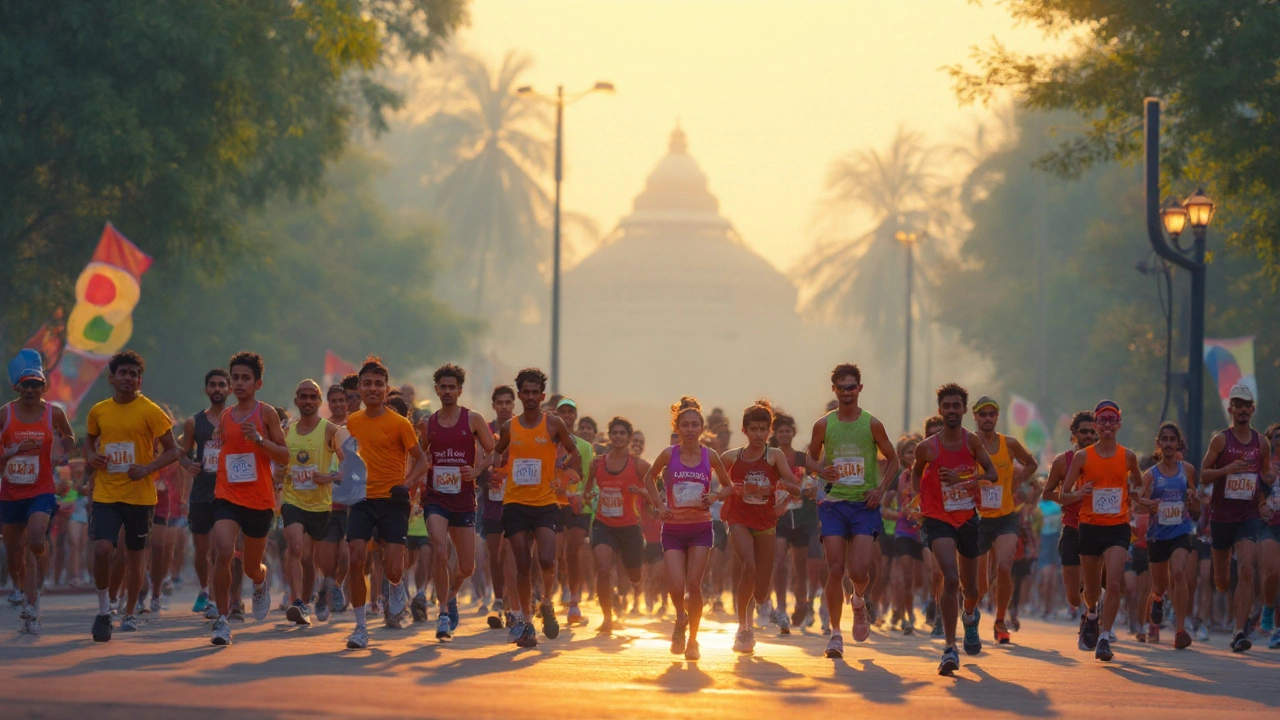Picture this: you're deep into your half marathon training plan, Brisbane sun beating down, legs coated in salt. By week 10 or so, your plan says "Long Run: 11 miles." That’s just over 17.7km. The finish line of a real half marathon sits at 21.1km—13.1 miles. The question? Can you stretch those last two miles on race day without crumbling, or is this just wishful thinking fueled by endorphins and Strava kudos?
The Distance Gap: Myth vs Reality
It almost feels unfair. You train your heart out, push your weekend runs into double digits, and suddenly the finish line looks just out of reach. But here's the twist: most half marathon training plans don’t have you run the full 13.1 miles before race day. In fact, stopping at 10 or 11 miles is completely normal—even for seasoned runners. Training isn’t about covering the exact race distance every time. The aim is to get your body familiar with consistent, challenging effort while letting you recover in time for the big event. Hammering through the entire 13.1-mile haul could leave you sore, risk injury, or burn you out before you even start the race.
But does this approach actually work? Surveys from major coaching services show that about 70% of recreational half marathoners never run the full distance before their event (Runner’s World, June 2024). Yet completion rates for well-trained runners are over 95%. The logic: your body adapts, builds endurance, and race adrenaline will help you squeeze out those last two miles, even if you’ve never done them in training. Runners call it ‘taper magic’—your peak fitness plus rest in the final weeks gives you a surprise edge on race day. Don’t worry, you won’t be alone suffering through that last stretch; it’s almost a rite of passage.
Why Do Training Plans Stop at 11 Miles?
If coaches know you have to run 13.1, why do so many half marathon plans cut long runs at 10 or 11 miles? It’s not laziness or sly sabotage—it’s about protecting you. Running is tough on joints, muscles, even your immune system. Training plans juggle pushing you hard enough to build endurance without tipping you into injury or overtraining. Most plans use incremental mileage increases (the 10% rule is a classic) and top out at 10-11 miles. This leaves space for your body to adapt, rebuild, and store energy for race day. Think of it as sharpening the knife instead of hacking away until it’s blunted.
Here’s something interesting from the American College of Sports Medicine (report published in March 2023): Muscle glycogen—the fuel you really rely on for those last few miles—has a “memory” effect. Your body gets used to efficiently storing and burning fuel even though you never test that final 2-mile push in training. Instead, you practice race pace during shorter midweek runs, and practice running on tired legs during your long runs. Those workouts wire your body for the real thing better than just slogging the full 13.1 all the time.
| Training Plan Longest Run | Finish Rate (%) | Avg. Half Marathon Time (hrs) |
|---|---|---|
| 10 miles | 95 | 2:17 |
| 11 miles | 97 | 2:14 |
| 12+ miles | 99 | 2:09 |
As you can see, there’s a small improvement with longer training runs, but finish rates stay high. The boost isn’t as huge as you might think. So don’t panic if your plan tops at 11. You’re well within the “safe to finish” zone.

Race Day Psychology: Can Grit Beat Distance?
Here’s where the mind game kicks in. The idea of doing something you’ve technically never done (running a full 13.1) is intimidating. Good news? Race day adrenaline is real. The crowd, other runners, music, even the smell of the sausage sizzle at the finish—these pump out enough energy to cover a surprising distance. According to a meta-analysis from the University of Queensland in 2022, runners on average perform up to 7% better on race days versus their best training sessions, all thanks to psychological and environmental factors.
But it’s not just hype and good vibes. Breaking a long run into smaller, manageable chunks is a strategy elite runners use. Focus only on the next kilometre, the next water station, that guy in the silly hat ahead of you. Each mini-goal keeps your mind from obsessing over the total distance. It’s mind-tricking, but effective, especially in those last, brutal miles.
If anxiety creeps in about those mystery extra miles, remind yourself: your body has done the training, so your job is just to keep moving forward. Having a mantra (“just keep going”, “strong finish”, or my personal weapon: “don’t let the wheels fall off now”) can pull you back from the edge if you wobble. Visualizing the finish before race day helps, too. Lots of study results back up this ‘mental rehearsal’ trick—it primes your brain to expect fatigue, so you’re less likely to freak out when it comes bite you.
Practical Tips for Nailing the Last Two Miles
Let’s get honest: the final two miles aren’t easy. You’re likely to feel a real physiological drop-off called “the wall”—a point where your legs feel like timber and everything in your head says stop. But it’s manageable if you plan for it. First, half marathon pace is king. Don't start too fast—it's the classic mistake—because burning through your energy stores early means real pain late. Aim for a steady pace that you held during your tempo runs or long training runs.
Nutritional strategy matters too. Start fueling before you feel empty. Most runners do best with a carb gel or sports drink every 30-45 minutes, but don’t try anything new on race day—practice with your preferred fueling in your longest training runs. Dehydration is the silent killer; even a 2% drop in hydration can zap your performance. The Brisbane heat loves catching out the unprepared, so take water at each station, and don’t be shy to slow to a walk if you need to finish your gel or drink.
Shoes make a difference, too. By race day, your runners should have about 60-100km on them—not box-fresh (they might blister), not worn out (they’ll lack bounce). Socks, body glide, and well-tested gear are way more important than you might think. No new shoes or shorts. Trust me.
Pidgin fatigue with creativity: change your cadence if you feel sluggish; wave at spectators; listen for the loudest cowbell and give a thumbs up. Tiny distractions pull your brain out of discomfort. But most of all, remember why you’re racing. It’s bigger than a number on a watch. You’re testing your limits, and that’s never a perfect science.
Now, a sneaky Brisbane bonus: late in big events like the Bridge to Brisbane or the Gold Coast Half, you can spot iconic landmarks cresting the horizon. Use them as mental anchors—"I just need to reach the Story Bridge” or “Surfers Paradise sign, here I come." This turns the last ugly kilometres into a victory lap.

What If You Haven’t Run 11 Miles Yet?
Feel undercooked? You’re not out of play. Maybe injury, work, or life threw off your plan, and you’ve maxed out at 9 or 10 miles. It’s not ideal, but don’t write off the half marathon. Your best bet is to run-walk: use intervals from the start (e.g., 9 minutes running, 1 minute walking). This saves your legs, keeps your heart rate in check, and preserves muscle fuel for later. The Galloway Method is famous here, and plenty of Aussies have finished Gold Coast or Sydney halves using this exact blueprint. Just stand by the pace, don’t let ego force you to skip your walk breaks early. It’s about making it to the line with your muscles—and your pride—intact.
But, whatever you do, don’t try to “make up for lost time” in the final weeks. Cramming extra-long runs in the two weeks before your race can wreck your recovery. Shorter runs, more stretching, and lots of sleep will do more good. It’s about showing up motivated and as healthy as possible.
The body is shockingly adaptable. If you’ve regularly run close to 11 miles, and your average weekly mileage is over 20km (a pretty common cut-off number for decent fitness), your probability of crossing the finish line is high—higher than the percentage who actually start training but never enter a race at all. Remember, most people in the starting corral are also nervous about the last few miles. That’s half the fun: seeing what you can do when doubt is chasing you.
